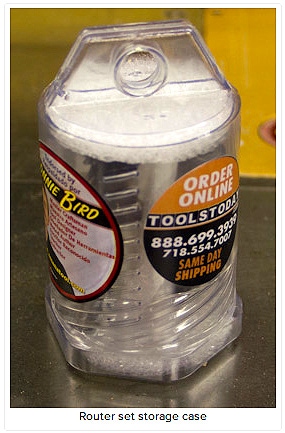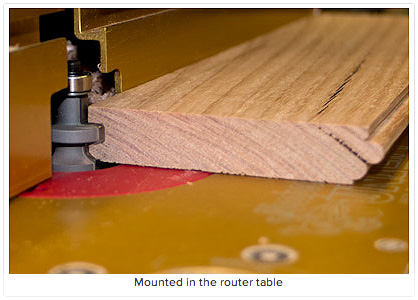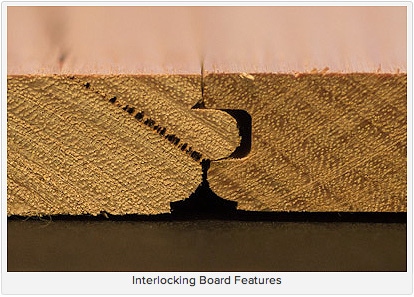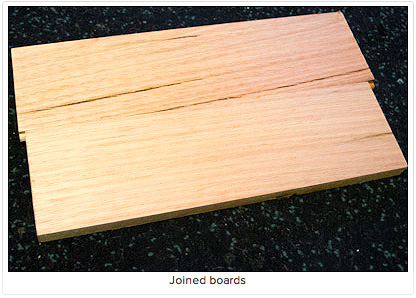Flooring the Opposition
How often do you find that you walk on a hardwood floor, to quickly realise that the floor is an illusion, that the wooden surface is nothing more than a thin veneer. You feel it underfoot – that springy feeling, and the sound, the slap each step of the floating panels hitting the floor underneath.
Another common polished timber floor are full thickness boards, but they are not tongue and grooved together, and each board is nailed down by an enthusiastic builder with a nail gun. And every nail hole filled with poorly colour-matched knobs of putty.
What if you have found some beautiful pieces of timber, either virgin or reclaimed that you would love to use? Then the solution is to make your own floor boards, and creating your own tongue and grooves is the way to go. A tongue and groove in its simplest form can join the boards together, Toolstoday.com has a much more refined bit set available from Amana Tool, and again a set endorsed by Lonnie Bird.


The set of two matched flooring router bits is particularly well made – I don’t normally notice the fit of the shaft in the router, but these bits were particularly well machined. Many companies ignore the shaft to a large extent, with microridges from the tooling marks on the shaft being acceptable. These were very fine – a really good fit, and smooth. You may think that smoothness leads to slippage, but that is not the case. Lubrication causes slippage, as does a limited contact area, and ridging can cause quite a drop in the contact area between the router shaft and the collet.
A smooth shaft maximises contact area, and therefore grip. If you don’t quite believe this, ask yourself why (in dry weather) Formula 1 cars perform best on slick tires.
Onto the rest of the two bits, and the finish remains immaculate. No rough brazing here, and quality carbide well backed up with the router bit base material.


The router bits have to be used in a table-mounted router, and a fence is highly desirable, if not a must. The router bits have bearings, but for thinner boards, the bearing does not contact the board. It still is very useful to ensure the fence is set to the right distance for the bit. Speaking of board thickness, there are two sets available – one flooring router bit set for boards 5/8″ – 3/4″ (which is the set I have), and the other flooring router bit set for boards 1/2″ – 5/8″.


One thing that these bits do not do, is cause the groove to be too deep, or the tongue too long. (We do not need a Gene Simmons endorsed router bit!) Once the boards are interlocked, you don’t need to risk having either portion of the board cracking or breaking off.
There are a number of other subtle developments that have been incorporated in the Amana Tool design.


Starting from the top of the joint, the two boards come together completely flat, ensuring the least amount of gap possible between boards. This is the only contact area between the boards in the horizontal plane, so seasonal change should have minimal impact on the joint.
The next feature is the tiny triangular indent out of the lefthand board. This is a gap for a hidden nail to be shot at an angle through the board to nail it to the joist that holds the floor up. Having a gap for this hidden nail prevents the head of the nail interfering with the joint. It also means it is easy to nail the board at an angle through the solid portion of the timber, rather than firing the nail vertically through the much thinner tongue, risking forming a split.
The tongue is short, and rounded, so there is one point of contact at the widest point of the tongue. The corners of the tongue, and the groove in which it engages are all rounded. This minimises the likelihood that a crack will start in the corner and break off the tongue, or the outer edges of the groove.
Finally, there is the large cavity at the bottom of the joint. It helps prevent moisture from gathering at the joint, and being wicked up into the joint.


Boards once joined together are seamless, with only the different grain of each board giving away where one finishes, and the next begins. Having a decent thickness adds to the overall quality of the floor, and being able to make the professional-style tongue and groove boards yourself can save a fortune, and also allow you to specifically choose the timber that the floor will be made from.
Once again, and unsurprisingly, a quality set of router bits from Amana Tool, and Toolstoday.com.
Originally posted on September 30th, 2012 by Stuart
Read the original article here.


